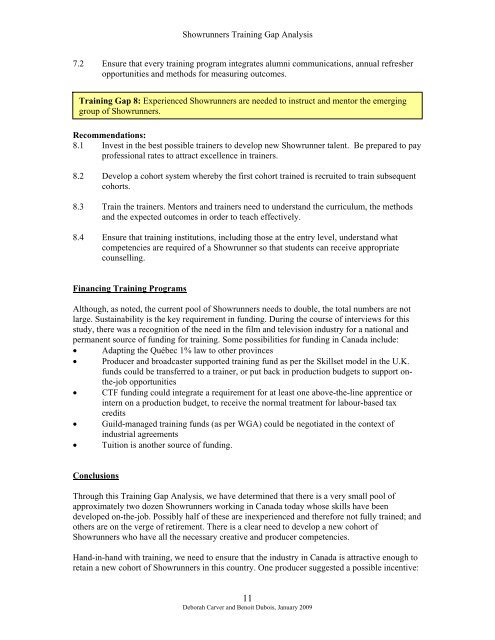Showrunners - Training Gaps Analysis - Cultural Human Resources ...
Showrunners - Training Gaps Analysis - Cultural Human Resources ...
Showrunners - Training Gaps Analysis - Cultural Human Resources ...
Create successful ePaper yourself
Turn your PDF publications into a flip-book with our unique Google optimized e-Paper software.
<strong>Showrunners</strong> <strong>Training</strong> Gap <strong>Analysis</strong><br />
7.2 Ensure that every training program integrates alumni communications, annual refresher<br />
opportunities and methods for measuring outcomes.<br />
<strong>Training</strong> Gap 8: Experienced <strong>Showrunners</strong> are needed to instruct and mentor the emerging<br />
group of <strong>Showrunners</strong>.<br />
Recommendations:<br />
8.1 Invest in the best possible trainers to develop new Showrunner talent. Be prepared to pay<br />
professional rates to attract excellence in trainers.<br />
8.2 Develop a cohort system whereby the first cohort trained is recruited to train subsequent<br />
cohorts.<br />
8.3 Train the trainers. Mentors and trainers need to understand the curriculum, the methods<br />
and the expected outcomes in order to teach effectively.<br />
8.4 Ensure that training institutions, including those at the entry level, understand what<br />
competencies are required of a Showrunner so that students can receive appropriate<br />
counselling.<br />
Financing <strong>Training</strong> Programs<br />
Although, as noted, the current pool of <strong>Showrunners</strong> needs to double, the total numbers are not<br />
large. Sustainability is the key requirement in funding. During the course of interviews for this<br />
study, there was a recognition of the need in the film and television industry for a national and<br />
permanent source of funding for training. Some possibilities for funding in Canada include:<br />
• Adapting the Québec 1% law to other provinces<br />
• Producer and broadcaster supported training fund as per the Skillset model in the U.K.<br />
funds could be transferred to a trainer, or put back in production budgets to support onthe-job<br />
opportunities<br />
• CTF funding could integrate a requirement for at least one above-the-line apprentice or<br />
intern on a production budget, to receive the normal treatment for labour-based tax<br />
credits<br />
• Guild-managed training funds (as per WGA) could be negotiated in the context of<br />
industrial agreements<br />
• Tuition is another source of funding.<br />
Conclusions<br />
Through this <strong>Training</strong> Gap <strong>Analysis</strong>, we have determined that there is a very small pool of<br />
approximately two dozen <strong>Showrunners</strong> working in Canada today whose skills have been<br />
developed on-the-job. Possibly half of these are inexperienced and therefore not fully trained; and<br />
others are on the verge of retirement. There is a clear need to develop a new cohort of<br />
<strong>Showrunners</strong> who have all the necessary creative and producer competencies.<br />
Hand-in-hand with training, we need to ensure that the industry in Canada is attractive enough to<br />
retain a new cohort of <strong>Showrunners</strong> in this country. One producer suggested a possible incentive:<br />
11<br />
Deborah Carver and Benoit Dubois, January 2009










